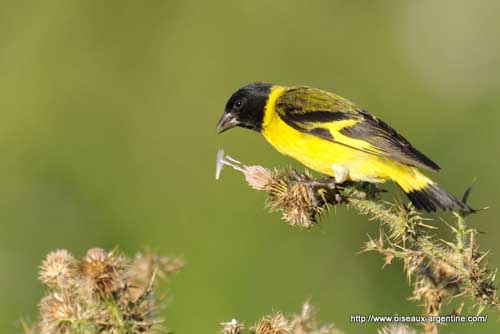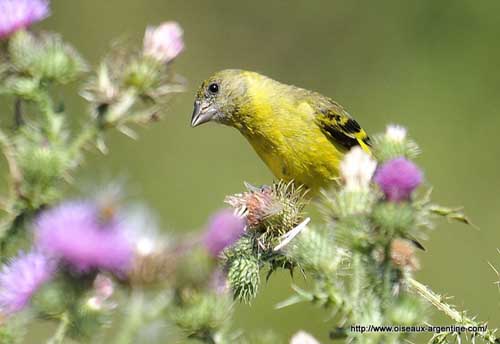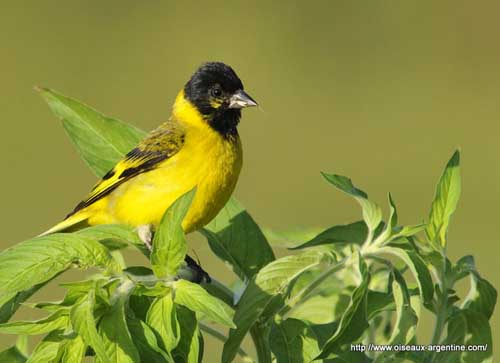
Fr: Chardonneret de Magellan
All : Magellanzeisig
Esp : Pardillo de Capota Negra
Ital : Lucherino di Magellano
Nd: Zwartkopsijs
Sd: Magellansiska
Port: Pintassilgo
Photographers:
Eduardo Andrés Jordan
MIS AVES – AVES DE ARGENTINA
Philippe et Aline Wolfer
GALERIE
Text by Nicole Bouglouan
Sources:
HANDBOOK OF THE BIRDS OF THE WORLD Vol 15 by Josep del Hoyo-Andrew Elliot-David Christie - Lynx Edicions – ISBN: 9788496553682
Ottaviani, M. (2008) Monographie des Fringilles (fringillinés – carduélinés) – Histoire Naturelle et photographies, Volume 1. Editions Prin, Ingré, France, 488 p.
Ottaviani, M. (2011a). Monographie des Fringilles (carduélinés) – Histoire Naturelle et photographies, volume 2. Editions Prin, Ingré, France, 286 p.
Ottaviani, M. (2011b). Monographie des Fringilles (carduélinés) – Histoire Naturelle et photographies, volume 3. Editions Prin, Ingré, France, 320 p.
BirdLife International (BirdLife International)
Wikipedia, the free encyclopaedia
Hooded Siskin
Spinus magellanica
Passeriforme Order – Fringillidae Family
BIOMETRICS:
Length: 10-12 cm
Weight: 11-15 g
DESCRIPTION:
The Hooded Siskin is a South American species. This brightly coloured Fringillidae is fairly common in its range, often heard when singing from exposed perch.
The adult male has black and yellow plumage.
Male of nominate race has black hood including head to nape, throat and centre of upper breast.
On the upperparts, lower nape to back and scapulars are olive-green, finely streaked dark. The rump is bright yellow whereas uppertail-coverts are olive-green. The tail is black, with outer rectrices broadly edged yellow at bases.
On the upperwing, coverts are blackish-brown. Greater coverts show paler tips, from pale olive-green to bright yellow. Primary coverts and flight feathers are black with yellow wing bar and wing patch.
On the bright yellow underparts, side of breast are often washed orange whereas flanks and belly are tinged greenish. Underwing coverts are bright yellow.
Bill and eyes are black. Legs and feet are dark grey to blackish.

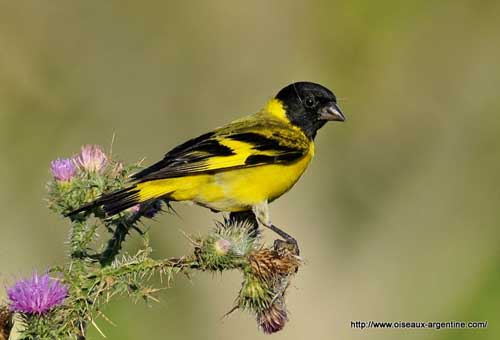
The female shows similar pattern but much duller, with dull olive slightly tinged grey head and upperparts. Rump is yellow to yellowish-green, and uppertail-coverts are green. The wing pattern is paler and less extensive than in male.
Chin and throat are pale greyish or pale olive. Underparts are tinged olive or greenish, except for whiter belly to undertail-coverts.
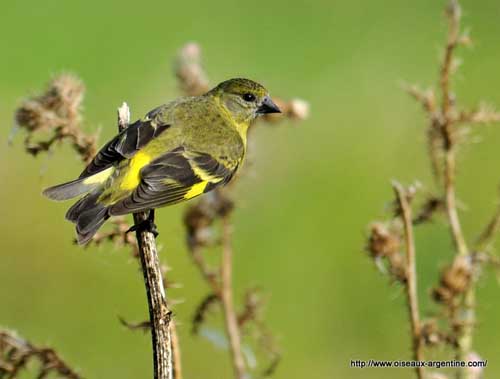
Juvenile resembles female with duller colours. Head and upperparts are buffish-olive finely streaked darker.
We can find 12 subspecies which differ in intensity of colours, with more or less contrast. The black hood can be less extensive on the upperbreast. Yellow wingbars and tail pattern can be narrower than in nominate race.
VOICE: SOUNDS BY XENO-CANTO
The Hooded Siskin usually sings from exposed perch or while flying. It may sing for long periods, uttering series of rapid “tseet-tseet, tseet-tseet” or “tseet-weet-a-weeta” interspersed with repeated phrases.
The call is a light “djey, djey”. We can also hear some “tseeuu” and long “trrrrr”.
Several males may sing in concert.
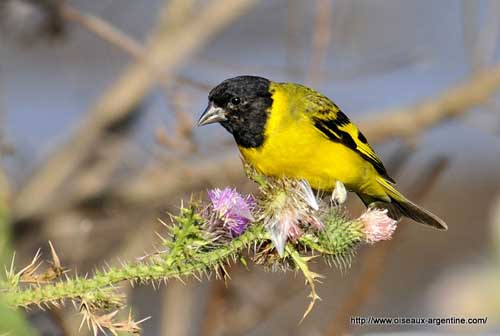
HABITAT:
The Hooded Siskin frequents lowland to lower montane woodlands, savannas with some trees and thickets, scrubland, groves and plantations, swamp-woodland, bushy areas, cultivated areas and edges, parks and large gardens near cities and towns.
This species occurs from sea-level up to 5000 metres of elevation according to the range.
RANGE:
The Hooded Siskin is found from C Argentina N to C Brazil. It occurs in the Andean region from NW Argentina and N Chile, N to C Colombia.
An isolated population is found in SE Venezuela, Guyana and northernmost Brazil area, Roraima (subspecies C.m. longirostris).
BEHAVIOUR:
The Hooded Siskin feeds in trees and bushes but also on the ground. Its diet includes mainly insects, but it also consumes buds and leaves of various plant species. Small insects are occasionally taken.
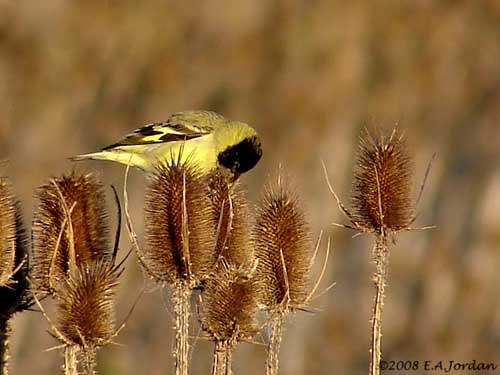
It usually forages from ground to treetops by moving quickly. It is very active and restless. On the ground, it moves by hopping.
It feeds alone or in pairs, and in small groups too. Outside the breeding season, they gather in large mixed flocks, usually with other birds of genus Carduelis. Some aggressive behaviour can be observed while feeding, but squabbles are usually short-lived and used by one bird to defend its individual space.
Feeding in flocks is also a good way to protect themselves against predators.
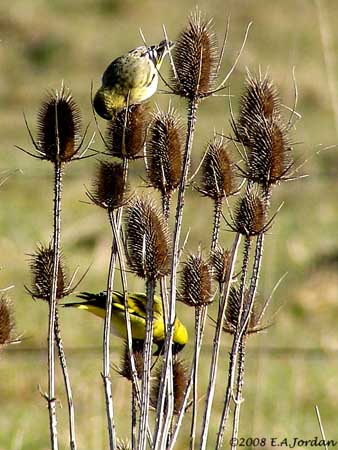
During the breeding season, the Hooded Siskin defends a small area around the nest as numerous finches of genus Carduelis do. Usually, they spend little time on territorial defence.
Pair-bonds are maintained by songs. Both mates stay together with the male accompanying the female everywhere and staying close to her while she builds the nest.
There is no information about the courtship displays of this species, but usually, these finches perform repeated ritualized aggression towards the female, raising the wings to display the pattern, the bill pointed upwards and then, lowering the wings to expose rump and tail colours. Chases may occur too.
The Hooded Siskin is resident and nomadic outside the breeding season, probably according to the food resources.
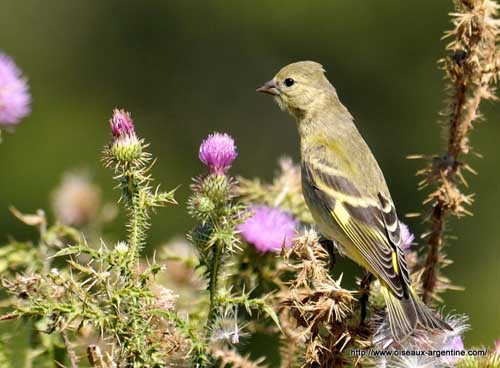
FLIGHT:
The Hooded Siskin performs undulating flight with periods of flapping flight interspersed with glides on closed wings.
REPRODUCTION:
This behaviour is poorly known.
Birds building the nest have been observed between October and January, and eggs are laid in March and June. Fledglings are visible in February and July. Such reports may indicate that these birds breed all year round.
The nest built by the female is placed at tall treetop. This is a small cup made with fine plant materials.

Female lays 2-3 eggs and incubates during 12-13 days. Usually, the male provides her food, including when the chicks hatched. She regurgitates this food directly into their open mouths.
The young birds fledge two weeks after hatching and still depend on parents for a few days.
DIET:
The Hooded Siskin feeds primarily on seeds, buds and leaves from several plant species such as thistles and Lactuca. It occasionally takes insects.
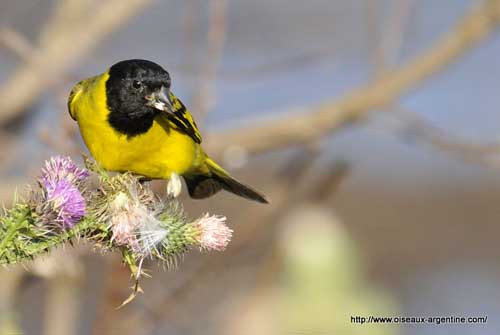
PROTECTION / THREATS / STATUS:
The Hooded Siskin is fairly common in its range, but this bird is often trapped for pet-trade. Some declines are noticed but currently, this species is not threatened.
